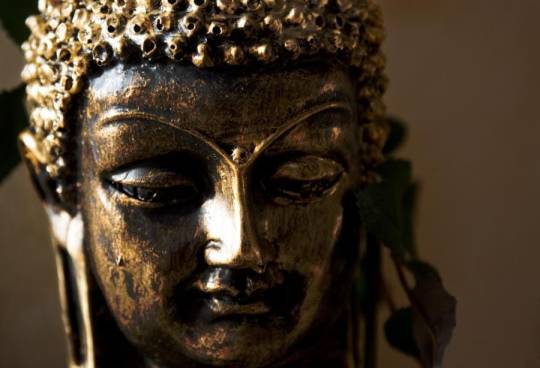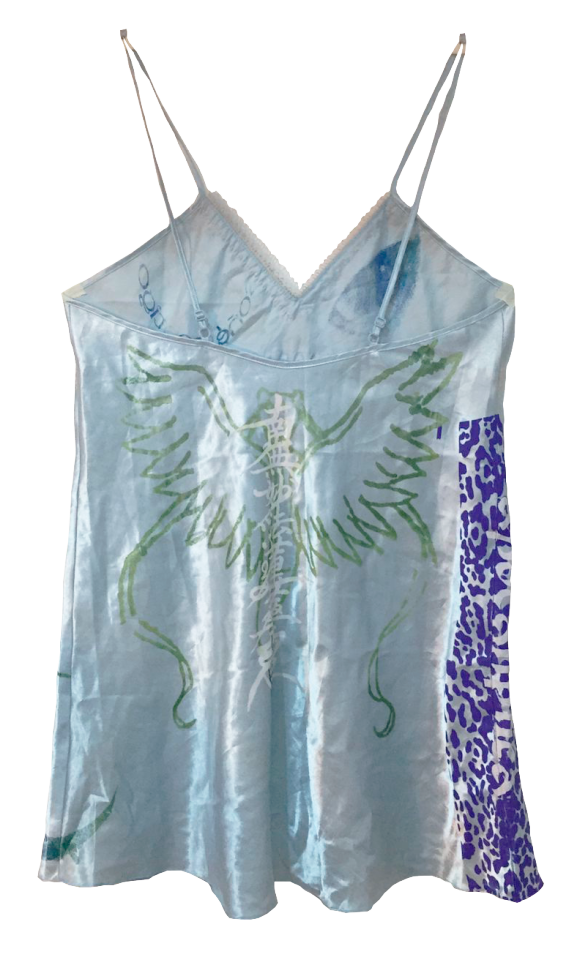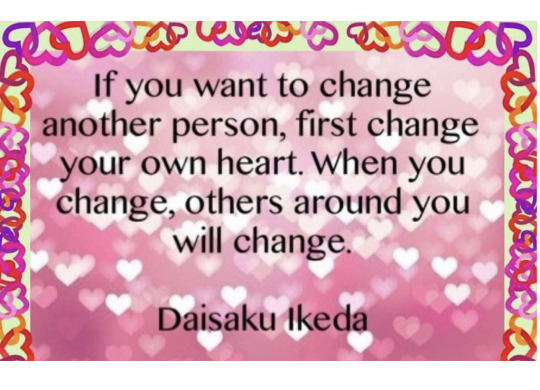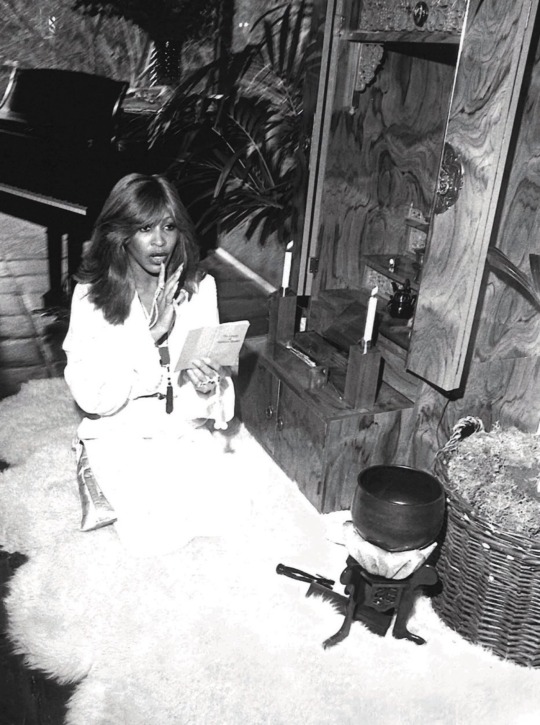#Nam Myoho Renge Kyo
Text

Namu Myoho Renge Kyo.
Statue of Inari Daimyojin
Nichiren Buddhist Sangha of Greater New England
#saijo inari#inari shrine#inari Okami#inari#inari daimyojin#nichiren shu#nichiren buddhism#nichiren#shinto#namu myoho renge kyo#Nam Myoho Renge kyo
25 notes
·
View notes
Text
Does my transgender identity conflict with Buddhism’s teachings on no-self?
by Sallie Jiko Tisdale, Narayan Helen Liebenson, and Andrew Holecek
Q: I was born male, but after many years of confusion, I’ve come to the conclusion that I’m actually a transgender woman and I’m now seeking sex-reassignment surgery. As a Buddhist, I feel conflicted by the teachings on no-self and this unshakable feeling that there is a deep, hidden truth about me that I need to express. Am I wrong to embrace this sense of true self?
SALLIE JIKO TISDALE: The emptiness of the self is part of what we face in practice. It is this very emptiness that allows us to work with our karma, clarify our lives, and awaken to the truth. But becoming your most authentic self is part of it too. The Buddha advised his followers to be indifferent to their bodies, but he also taught people to use their bodies as the tools of awakening. The Buddha’s own story teaches us that extremes are not conducive to real understanding. It does us no good to be miserable, unhealthy, or at war with ourselves.
As human beings, we are always broken in some way; our existence is marked by ignorance and confusion. Over time, we come to accept the karma of our birth, the gifts and challenges we have inherited. We strive to become whole, to find those parts of the self that need attention and support. We become willing not only to accept our karma but also to dance with it—to risk vulnerability, to examine our tender places, to be uncomfortable, and finally to stand up for ourselves and say, “This is who I am.”
As you say, you sense a “deep, hidden truth” about yourself and you need to express it. Everyone feels this way, I think. To one extent or another, we are longing to be seen and recognized as we secretly know ourselves to be. We struggle to find congruence between our inner experience and our outer relationships. So we work to bring the physical body and our appearance into congruence with the felt self—through our clothing, how we wear our hair, how we speak and stand, whom we choose as friends and peers.
Each of us has genitals, but they do not determine gender. Our gender—male, female, or intersexual—includes such disparate forces as genetics, family, and culture. The source of transgender identity is mysterious because we don’t understand how all these forces work together. But the incongruence you feel is not that uncommon. I would advise only that this felt identity is not your “true self.” The Buddhist true self is much more than our phenomenal existence. That self is not dependent on the physical body, intellect, spiritual practice, or relationship; it cannot be obstructed by anything phenomenal.
What you describe is what I think of as the “authentic self,” the urge to live in this world in the most whole way possible. For some of us, it might mean braces or a different haircut; for others, it may mean monastic robes and a shaved head. For a certain number of people, it will require gender-reassignment surgery. So yes, embrace your authentic self completely. If that means you need to make some practical adjustments, you will have plenty of company.

NARAYAN HELEN LIEBENSON: The teaching of anatta does not say there is no self; it states that nothing conditional can be pointed to as being who or what you are. Given that no aspect of being can be identified with in any kind of continuous, independent sense, to me, teachings of compassion and loving-kindness can be your north star.
You don’t mention pain, but it’s hard to imagine that you’ve made this decision lightly and without any degree of angst. This pull you feel to live as you know yourself to be is a matching of your inner reality with the outer situation in which you live. What could be wrong with that? Accepting yourself as you are and being a true friend to yourself is an essential aspect of this path of inner liberation.
I see the problem as the conflict between what you know and what you have heard in the teachings. The question is, by manifesting differently in this world, can you live the teachings more fully? I would assume so, because after surgery, you will not live in ongoing conflict or feel a sense of separation between the gender you know yourself to be and the way others relate to you. Free from the idea of a fixed, continuous, independent “I,” there’s tremendous freedom possible in the flowering and flexibility of all things.

ANDREW HOLECEK: My heart goes out to you. Matters of identity at any level are wrenching. But fortunately, the challenges are also in direct proportion to the potential for transformation—the greater the obstacle, the greater the opportunity. Your question is a marvelous opportunity to explore the relationship between absolute and relative truth, both of which need to be honored to fully address the issues you express. We find our way to the absolute through the relative, not by dismissing it—your courage in facing yourself so honestly at this relative level can take you far along the path.
To become a buddha (the absolute), we first have to become fully human (the relative). We then might discover that to be fully human is to be a buddha (the inseparability of relative and absolute). One thread that connects these two stations along the path is maitri, or loving-kindness toward oneself. So first and foremost, be kind to yourself, which in itself is transformative.
If the Buddha were here, he would want you to be happy. If becoming a woman truly makes you happy, he would encourage that. But he might also suggest that your longing for change points to something even deeper, as your question itself implies. So while it’s important to honor the relative, the strength of Buddhism lies in its teachings on the absolute. That’s the perspective I want to emphasize.
Your question suggests to me that you’re homesick for the absolute, and that homesickness is expressing itself in this relative way. This is not to dismiss your desire to find a true form but to help you put it in perspective. Sex reassignment could be just one step toward the recovery of the “true self” you’re looking for.
In many ways, this is the central inquiry of the spiritual journey. Ramana Maharshi developed an entire path based on the question “Who am I?” Not knowing the answer is the source of all our suffering; discovering it is the basis of our liberation.
Until we wake up to who we really are, we’re all victims of a primordial identity theft. You originally thought you were a man, only to find you’re actually a woman. Good for you. You’re looking within and trying to recover a truer identity. But the finite cannot contain the infinite; if we identify with that form, it will always feel like something is missing.
How can you work with the absolute level? Even as you move forward with your surgery, when the thought comes up that you’re a woman—or a man—try to identify with the space between those thoughts. Let those thoughts come and go like clouds floating through the open sky. You’re the sky. Take refuge in that. From that open perspective, you will relate to whatever arises in your heart and mind properly and no longer lose yourself in any form. So abandon even the concept that “My thoughts are me.”
Take your unshakeable feeling that there is a deeper truth and use it to propel you toward that truth. That feeling is beautiful. Let your choice and your questions serve as catalysts for deeper investigation. Once you properly identify yourself as no-self, you will naturally express that selflessness as compassion and fulfill your longing—in any form. That’s when you’ll really shine.
#nam myoho renge kyo#buddhadarma#gender#trans buddhists#trans bodies#buddhist#look to the dharma itself not the carryovers from its mixture with various cultures#articles
15 notes
·
View notes
Photo


peça piloto ~ soñe contigo
#sleep#dream#dress#upciclyng#silkscreen#sailor moon#nam myoho renge kyo#sueños#blue#brazil#trans#transparent
21 notes
·
View notes
Text
this morning when I did gongyo I broke down crying because I was so stressed about work.
The day before I held a meeting with my supervisors requesting my salary be raised to accommodate cost of living where I am. I poured my heart out to my bosses telling them that I was financially struggling and it was making it difficult to fully focus at work because each week I decide to pay rent or buy groceries. I had been eating nothing but rice beans and old bread and they told me that they couldn’t justify giving me a raise and informed me that I was actually going to be making less than our prior agreement. I was completely discouraged I cried and cried because I thought they cared about me. I genuinely tried to be a good worker for them.
After that discussion I began applying to different positions and researching graduate programs as I really have missed university and do want to pursue my MA & PHD.
This morning when I was chanting I was trying to figure out what to do. Do I stay at this company that doesn’t care about me? I was honestly considering it just for the sense of financial security. I absolutely hated that job and dreaded waking up in the morning. What’s the point in working from home if you can barely afford to keep your home working 40hrs a week for a company? I chanted for clarity and good fortune and above all to bring out my inner Buddha nature and not let discouragement keep me from being my best self. I was committed to be the best version of myself regardless of anything that could get me down. I just chanted that whatever needed to happen happened.
Well today i got fired from that job! I got fired when i was about to enter an interview for my new better paying position close to home! Then I got approved to freelance as a tutor and editor. And then finally my graduate application fees got waived, the need for references got waived, and I found out my GPA was high enough to enter the program and everything worked out beautifully!
If it wasn’t for my own courage to demand better at work I wouldn’t have had the conversation with my bosses that lead me to realize it was time to go back to school and find a change of employment. I wouldn’t be experiencing the beautiful fortune that I’m experiencing now.
2 notes
·
View notes
Photo

Want a new you, then change you!!!
#theyearofyouthandtriumph
17 notes
·
View notes
Text
I am sooooo Buddhist. It's crazy how when I'm on my practice, the universe speaks to and through me so clearly....it puts me in this indescribable ultimate alignment...I chanted the diamoku, the angels kept everything together by their threads. It's with me in every moment
3 notes
·
View notes
Link
What does Nam Myoho Renge Kyo mean?
“Life is really simple, but we insist on making it complicated.”
— Confucius
If you search the internet for the history and meaning, plan on spending at least 30 minutes browsing the hundreds of pages you will find, and if you manage, then try to explain it to someone else, so here is a simplified version for you.
2600 years ago, Gautama Siddhartha, founder of Buddhism, awoke to the “Lotus Sutra” and the universal truth of “Myoho Renge Kyo.”
In the year 1253, when Nichiren Daishonin, founder of the branch of Japanese Buddhism, known as Nichiren, told his disciples for the first time that the Lotus Sutra or “Nam Myoho Renge Kyo,” is the fundamental principle within the entire teaching of this Buddhism.
This mantra harmonizes our life with the perfect rhythm of the universe, increasing good fortune, health, life force, and wisdom.
It is difficult to translate this mantra, consisting of the Sanskrit word “Nam,” and the Japanese pronunciation of the “Lotus Sutra” translated from classical Chinese.
To understand its meaning, we have to analyze each of its parts:
NAM
“Peace begins with a kind gesture and Namaste.”
— Debasish Mridha (American philosopher, poet and author)
NAM is a Sanskrit word derived from “NAMAS” and is used to express devotion. It comes from the same root of “Namaste,” used in the practice of meditation and yoga, as a greeting which means “I bow before you,” or in a more profound sense, “I bow to the divine presence in you.”
Therefore, we can translate NAM as:
“I bow down to the divinity that exists within me / you.
MYOHO
“Our life is the expression of the mystical law”
— Nichiren Daishonin founder of Nichiren Buddhism
MYOHO is the union of MYO, which translates as a mystic, and HO, or the law. Therefore, we can translate MYOHO as “Wonderful Law,” or “Mystical Law,” considered in Nichiren Daishonin’s Buddhism, as:
The primary Law or reality permeates all the phenomena of the universe.
We can conclude MYO is the mystical and infinite, the name given to what we do not see, the intangible, and the dynamic life force of the universe, and HO is the visible and tangible aspect of this force.
Both together form the reality of life. The ever-changing phenomena of HO, but bathed in a constant reality known as MYO.
MYO “Mystic,” + HO “Law,” = MYOHO “Mystic Law.”
RENGE
“As the lotus rises on its stem without being stained by mud and water, so the sage speaks of peace and is not stained by the opinions of the world.”
— Buddha
RENGE means ‘lotus flower.’ Unlike most plants in which the flower first appears and then transforms into a seed, the lotus is one of the few that produces both flower and seeds simultaneously. Nichiren Buddhism regards the lotus as the union of cause and effect.
Each action creates a cause through our actions, words, or thoughts, generating a simultaneous effect. The results are manifested in our lives and what surrounds us. Also known as the law of cause and effect, or Karma and Dharma.
Another characteristic of the lotus plant is that it grows in swamps or muddy ponds. However, it blooms white and without spots. In Nichiren Buddhism, this lotus’ quality symbolizes the pure and unblemished emergence of our personal Buddha.
So, we can define RENGE = as the manifestation of our inner untarnished Buddha responsible for the law of cause and effect.
KYO
“You have to grow from the inside out. No one can teach you, and no one can make you spiritual. There is no other teacher than your soul.”
— Swami Vivekananda (19th-century Indian mystic)
Buddhists translate KYO as a sutra, sound, teaching, or “the voice of the Buddha.” However, the sinogram (Chinese character) of KYO also represents the threads connected in a loom.
For Nichiren Daishonin, it is the union or link that connects everything through eternity. The continuation of life uniting the past, present, and future of the universe, and that in Myoho Renge Kyo, represents the enlightenment of the living Buddha, transmitted throughout eternity.
NAM-MYOHO-RENGE-KYO
“Nam Myoho Renge Kyo is like the roar of a lion. Therefore, what disease can be an obstacle?”
— The Writings of Nichiren Daishonin
If we unite all the elements, Nam-Myoho-Renge-Kyo, we can translate it as:
Nam = I bow down, I line up, I surrender.
Myoho = Mystic Law.
Renge = Lotus Flower, Buddha without blemish.
Kyo = Sutra, teaching, the voice of Buddha, the union of the past, present, and future.
Putting all parts together, we can generate the following sentence, “I bow down to the mystical law of the Lotus Flower Sutra,” or in a more profound sense:
I align myself with the voice of the spotless Buddha, accepting his teaching of the law of cause and effect that links my past, present and future.
HOW DO YOU USE NAM-MYOHO-RENGE-KYO?
“Repeating a mantra opens the heart and makes love flow within us.”
— Swami Muktananda (Siddha Yoga)
The Mantra of the Nam-Myoho-Renge-Kyo suggests we bow and surrender to the Name of a Higher Power and the Mystic Law. That blooming like a lotus makes us bloom and feel happy, beautiful, full of energy, life, and always young. When we dedicate ourselves to that One Whole of which we are part, our sufferings vanish.
You can repeat the Nam-Myoho-Renge-Kyo mantra for five minutes, or for only ten times, at dawn, preparing to accept any event as an opportunity for growth and learning, and before going to sleep as gratitude for all the teachings that the day gave us.
What are the benefits of Nam-Myoho-Renge-Kyo?
“When you repeat Nam-Myoho-Renge-Kyo, little by little you eliminate all the poor decisions that you’ve made. The more you repeat it, the more you clarify your life and you will get closer to your true nature, avoid wrong decisions.”
— Tina Turner
You can find thousands of google pages, from Buddhist monks, Meditation gurus, and even Tina Turner. But let me tell you my experience using this technique.
I discovered it some time ago. When I had lost my job, had marriage problems, and my health was terrible. And this was before the 2020 pandemic!
Looking for some way to cope with all my problems, I heard someone talking about how it helped Tina Turner.
It was so simple that it just made a click, and the words stuck in my mind. Later I tried to find the meaning, but after searching for several hours, I decided to give it a try.
I printed two copies and put one in my wallet and the other by the door to see it when I left or returned home.
Since then, each time I leave the house, I see it as a reminder of the opportunity to learn from everything that day and be grateful at night.
If something happens during the day, and my brain goes into auto-response mode, I stop and remember the card by thinking: What’s in your wallet?
Therefore, when I face some problem, something happens, or my cynophobia (fear of dogs, not xenophobia, fear of foreigners), I repeat the mantra and feel calm.
Other benefits I experience are:
It gives me the ability to deal better with problems and difficulties.
Overcome fear, stress, and phobias.
It helps me to control anger and gives me confidence before any presentation.
I change any submissive behavior when I want to say yes or no to something to avoid upsetting others, fearing to hurt their feelings.
Relax my mind and body after any stressful situation.
See things more clearly to find a win-win solution in a conflict.
At night before I sleep, I feel love, happiness, joy, and peace.
It helps me feel grateful for everything that happened during the day.
IN CONCLUSION
“Suffer what you have to suffer, enjoy what you have to enjoy. See suffering and joy as facts of life, and continue to sing Nam Myoho Renge Kyo, whatever happens. How could this be anything other than the joy? of the Unlimited Law?”
— The Writings of Nichiren Daishonin
Imagine the immense benefit you’ll gain from just earnestly reciting the Nam-Myoho-Renge-Kyo Sutra in the morning and at night for as little as ten times.
In Nichiren Buddhism, the object of devotion is usually printed on a scroll with calligraphic Chinese and Sanskrit characters placed by the door.
Nichiren never writes about the number or the times we should repeat the sutra. He only explains that it depends on the consciousness of each individual. Still, it is essential to do it a little each day.
Therefore, we must strive to live each day and improve ourselves by practicing in the morning and night continually.
8 notes
·
View notes
Text
When you wanna be petty but you’re trying to be a good person.
2 notes
·
View notes
Text

Ita Airways, dedica a Roberto Baggio l'A350 con una speciale personalizzazione sui sedili, il canto buddista “Nam Myoho Renge Kyo”.
L'ex calciatore: "Orgoglioso ed emozionato dell'aereo a mio nome".
Un grande italiano, conosciuto ovunque, anche oltre oceano, un uomo tanto famoso quanto per bene, che continua ad emozionare tutti con la sua semplicità e la direzione del suo cuore.
Tiziana Cerra
#RobertoBaggio #ikigai #NamMyohoRengeKyo #RobyBaggio #ITAAirways #A350 #italia #italy #giappone #giapponese #japan #japanese #daisakuikeda
#roberto baggio#daisaku ikeda#amarsi#frasi forza#coraggio#tumblr#saggezza giapponese#giapponesi#giappone#tizianacerracounselor#love trainer tiziana cerra#tizianacerra#tizianacerralovetrainer#lovetrainertizianacerra#lovetrainer#ita airways#frasi tumblr#buddismo#resilienza#nam myoho renge kyo#amore tumblr#Daimoku#gosho#universo#risveglio#saggezza antica#saggezza orientale#saggezza#felicita
3 notes
·
View notes
Text
“The pioneering spirit is a spirit of challenge. We cannot expect to realize fresh victory by using the same methods and taking the same action as before. We need to bring forth courage each day, challenge our limitations, and continue to press forward one step at a time. Therein lies the secret to victory.”
- NHR vol 15 p54
#new human revolution#sgi buddhism#daisaku ikeda#human revolution#guidance#soka gakkai#nam myoho renge kyo
1 note
·
View note
Text

"Viver é enfrentar um problema atrás do outro. O modo como você o encara é que faz a diferença."
0 notes
Text
It’s great to see certain things you love about others and proceed to implement those good qualities into your life. It’s also good to see the negative habits of others (especially family members) and from that moment on, work your hardest everyday to not engage in said behavior for your well-being and that of those around you.
#since l've started my Nichiren Buddhist practice something I have to constantly remind my self of is#no matter what’s happening around me I have the choice to decide how I respond to hard situations#when I feel a moment of judgment or even anger at someone I remember that we are all mirrors of each other#some of us are more hurt than others and don’t necessarily have the emotional tools to calmly handle situations#this can be SO hard to remember especially when we’ve healed or are doing the work to heal from the past#but when we have any type of spiritual or grounding practices apart of our lives (I personally chant nam myoho renge kyo) we can really#help those around us (and at a distance) by changing what’s within ourselves
7 notes
·
View notes
Text
I draw too.
I need to start posting my own artwork. I love how tumblr is a place where all types of art are accepted as well as the people who make it. Tumblr has become a safe space for me and I am grateful for everyone who contributes to this sacred space and wonderful community.
#great artist#art#art community#spirituality#spiritual awakening#Nam Renge Myoho Kyo#namaste#i love jesus
0 notes
Photo

I don’t know why exactly but Juzumaru looks hot as fuck here. They did his bangs differently or something, but damn I wanna use that hair as reins while I ride him like horsie
#Nichiren would approve as long as we do daimoku while we fuck! it's fine!#Nam myoho renge kyo -oh yes oh yes#I'm the world's absolute worst most depraved Buddhist
0 notes
Text
Sofra o que tiver que sofrer, desfrute o que existe para ser desfrutado. Considere tanto o sofrimento quanto a alegria como fatos da vida e continue recitando Nam-myoho-renge-kyo, independentemente do que aconteça. (CEND, 2014, v.I, p.713)
0 notes
Text


Tina Turner reciting the Lotus Sutra and chanting “Nam-myoho-renge-kyo” during her morning prayers.
1K notes
·
View notes